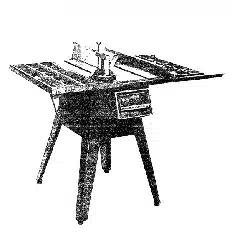Loading ...
Loading ...

ADDITIONAL SAFETY iNSTRUCTiONS FOR TABLE SAWS
WARNING: FOR YOUR OWN SAFETY, DO NOT
OPERATE YOUR SAW UNTIL IT iS COMPLETELY
ASSEMBLED AND iNSTALLED ACCORDING TO
THE iNSTRUCTiONS... AND UNTIL YOU HAVE
READ AND UNDERSTAND THE FOLLOWING:
1. GENERAL SAFETY iNSTRUCTiONS FOR
POWER TOOLS... SEE PAGE 2
2. GETTING TO KNOW YOUR SAW... SEE PAGE
23
3. BASIC SAW OPERATION . . . SEE PAGE 28
4. MAINTENANCE .............. SEE PAGE 41
5. STABILITY OF SAW
tf there _sany tendency for the saw _o t_p over or
move aunng certain cutting operations SUCh as
cutting extremely large heavy pane_s or tong
heavy boards, the saw shou{d De bolted down
tf you attach any kind of table extensions over
24" wide to either end of the saw make sure you
either bo_t the saw to the bench or floor as
appropriate, or suppor! the outer end of the
extension from the Denon or floor as
a ppropnate°
6. LOCATION
The saw should be positioned so neither the
operator nor a casual observer is forced to stand
m line with the saw bJade
7. KICKBACKS
A "KICKBACK' occurs during a rip-type
operation when a part or all of the workpiece is
thrown back v_olentty toward the operator,
Keep your face and body to one side of the
sawblade, out of ti ne with a possible "Ktckback °"
Kickbacks --- and possible injury from them --
can usually be avoided by;
A. Mmntaming the np fence parallel to the
sawblade,
B Keeping the sawbJade sharp, Replace or
sharpen antikickback pawls when points
become duH
C Keeping sawblade guard, spreader, and
antik_ckbackopawls in place and operating
properJy The spreader must be in alignment
w_th the sawblade and the pawls must stop a
kickback once ft has started Check their
action before r_pp_ng
D, NOT ripping work that is twisted or warped or
does not have a strmght edge to guide along
the rip fence,
E NOT releasing work until you have pushed it
al! the way past the sawblade
F, Using a push stick for ripping widths of 2 to 6
in., and an auxiliary fence and push block for
ripping widths narrower than 2 in, (See "Basic
Saw Operatton Using The Rip Fence"
section. )
G NOT confining the cut-off piece when
ripping or cross-cutting.
8. PROTECTION: EYES, HANDS, FACE, EARS,
BODY
A. if any part of your saw is missing,
malfunctioning, or has been damaged or
broken = . . such as the motor switch,
electronic controls, or other operating
particular part is properly repaired or
replaced,
3
B Wear safety goggtes that comp}y with ANSI
Z87,1, and a face shietd or dust mask if
operation is dusty, Wear ear p{ugs or muffs
during extended periods of operatior__
C, Small _oose pieces of wood or other objects
that contact the rear of the revolving biade
can be thrown back at the operator at
excessive s_)eed This can usually oe avoided
by keeping the guard and spreader m D_ace
for aH tnru_',sawmg operabons _sawing
ent_re_y thru the work) AND oy remowng ali
1oose p_eces from the tab!e w_th aiong stick of
wood _MMEDtATELY after they are cu_ off
D, Use extra caution when the guard assembw _s
removed for resawmg, dadoing, rabbeting, or
molding -----replace the guard as soon as that
operation is completed
E For r_p or rip-type cuts. the following end of a
workp_ece to which a push st_ck or push
board _s applied must be square
(perpendicular to the fence } in order that feed
pressure applied to the workp_ece by the
push shck or block does not cause the
workp_ece to come away from the fence and
possibly cause a kickback.
F During np and rip type cuts. the workpiece
must be held down on the table and against
the fence with a push stick, push block, and
featherboards as required A featherboard is
made of solid lumber (at teast 3/4"" thick) per
sketch,
- 24"",
_/_6' APART
i
G NEVER turn the saw "ON" beforecieanng the
table of all tools= wood scraps_ etc.. except the
workpiece and related feed or support
devices for the operation 131anned
H NEVER place your face or body _n line with
the cutting tool.
I. NEVER place your fingers or hands in the
Path of the sawblade or other cutting tooI
J 'NEVER reach in back of the cutting tool with
either hand to hold down or support the
workpiece, remove wood scraps, or for any
other reason. Avoid awkward operations and
hand positions where a sudden slip could
cause fingers or hand to move into a
sawblade or other cutting tool,
K, DO NOT perform layout, assembly, or setup
WOrk on the table while the cutting tool _s
rotating.
L, DO NOT perform any operation
"FREEHAND" -- always use e_ther the rip
fence or the miter gauge to position and
guide the work.
M. NEVER use the rip fence when crosscutting
orthe miter gauge when ripping. DO NOT use
the rip fence as a length stop.
Never hold onto or touch the "free end" of the
workpiece or a "free piece" that is cut off.
while power is "ON" and/or the sawb|ade _s
rotating.
Loading ...
Loading ...
Loading ...
